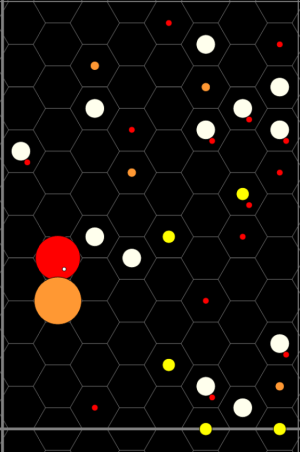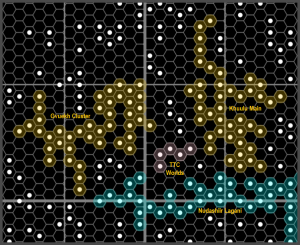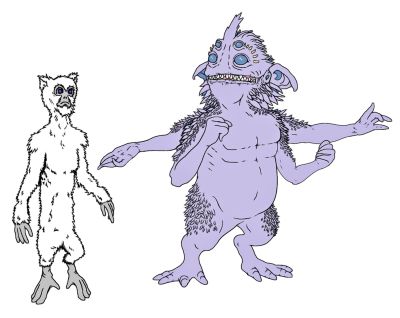Khuulu Subsector
| Khuulu Subsector | ||||||
|---|---|---|---|---|---|---|
| ||||||
| Sector | Meshan | |||||
| Capital | Enan | |||||
| No. of Stars | 30 | |||||
| Majority Control | Voekhaeb Society - 60% | |||||
| 2nd Control | Opposition Alliance - 37% | |||||
| 3rd Control | 17th Disjuncture - 3% | |||||
Khuulu Subsector is Subsector M of Meshan Sector.
- It lies within Charted Space.
- It is part of the Vargr Extents.
Description / Specifications[edit]
Khuulu Subsector is a region that has seen millennia of settlement by both humans and Vargr.
- The resources of the subsector are being exploited.
- Many worlds have ruins and remains on their surfaces dating to before the founding of the Ziru Sirka.
Astrographic Features & Trade Routes[edit]
The following astrographic and commercial data has been determined regarding Khuulu Subsector:
- The subsector is an average stellar density region.
- It contains no significant rifts or voids.
- The brightest star is the turbulent red bright giant primary of the Kalih system.
- The subsector lies at the conjunction of three important trade routes, including the Nudashiir Lagani, the great Lishun-Gashikan Main. The region is dominated by the activities of the Tukogan Trade Circuit.
Stellar Distribution[edit]
A basic map showing the distribution and size of stars within Khuulu Subsector.
- The color corresponds to the visible color of the star, which links to its spectral classification.
- The size as shown indicates both the physical size of the object and its relative brightness.

(Chart sourced from Traveller Map).
Note that the stars as depicted are representative. Any star, no matter what its size, is a mere speck within the hex it occupies.
- Ordinary main sequence stars can barely be seen from even a hex away.
- Huge, intensely luminous giant stars can be seen from across the subsector and far beyond.
Tukogan Trade Circuit[edit]
The subsector lies at the conjunction of three major local trade routes: the Gvuekh Cluster, the Khuulu Main, and the far spinward branch of the huge Nudashiir Lagani.
The subsector is dominated by the activities of the Tukogan Trade Circuit (the TTC). It is a fractious trade association made up of disparate interests and groups, with links to many worlds and organizations.
- It facilitates trade and commerce across the region.
- It has a significant degree of influence over the worlds at its core.

(Chart sourced from Traveller Map)
World Listing[edit]
AAB library archives contain expanded data about the following systems:
- The primary source material for all data is Traveller Map.
- Other sources may contain contradictory or incorrect information.
Note that some Second Survey data, though only 40 years old, is likely to be out of date.
- Data is occasionally updated as new information becomes available.
- Scouting missions gathering reliable, verified data can receive substantial payment.
- Verified updated data is constantly sought.
History & Background / Dossier[edit]
The name of the subsector is Vilani in origin: during the Ziru Sirka the region had billions of human inhabitants and its worlds were generally more technologically advanced. It later came under the authority of the Rule of Man and remained an important local power long into the Long Night.
Polity Listing[edit]
The following polities lie within the subsector:
- Vargr Extents - (Vargr Powers):
Capitals[edit]
- Enan serves as the subsector capital of the Opposition Alliance.
Native Sophonts (NILs)[edit]
No races (sophont species) are believed to have originated in this area.
Demographics[edit]
Significant populations of the following races (sophont species) reside within this area:
- Terragens (Non-human Terran races)
- Vargr (Major Race): the majority population within the sector.
- Non-Human Races
- Aezorgh of Soghzalghag: native to Windhorn Sector and sparsely distributed across the Vargr Extents. Their name translates as "vermin".
- Dhaen of Dhaen, in Provence Sector: small, long-bodied, fur-covered humanoids not recognized by the Vargr as being sophont.
- Some Vargr keep them as pets or as servants.
- Hlanssai of Vrirhlanz, in Gzaekfueg Sector: sensual, impulsive, emotional humanoids with a strong wanderlust who may occasionally be encountered in small groups.
- They are considered "unstable" by the notoriously unpredictable Vargr.
- Humaniti (Human Races)
Subsector Timeline[edit]
Major events that have affected this subsector and the wider region that it lies within:
- -9235: the Vilani discover jump technology and gradually spread from their homeworld, primarily following Mains.
- -4045 to -2204: the Ziru Sirka claims and settles worlds across the region.
- -3810: the Vargr discover jump technology and begin an era of expansion.
- -3700s onwards: waves of Vargr settle worlds across the region.
- -2404 to -2215: the human Interstellar Wars rage to rimward.
- -2204 to -1776: the Rule of Man nominally administers the rimward worlds of the region. Conflicts escalate between Vargr and humans as the Vargr occupy former Ziru Sirka territory.
- -1998: the First Empire of Gashikan is formed.
- -1776 to 0: the Long Night. There is widespread regression within the area and some worlds become barren.
- circa -1700: Vargr rimward expansion gradually ceases: the border between human and Vargr space stabilizes.
- -1658: the Sack of Gashikan, an atrocity known throughout the coreward parts of Charted Space.
- -1483 to -321: the Gashikan Race Wars rage between human and Vargr extremists across the Extents.
- -1427: the Wolvesbane plague is released in Gashikan Sector, decimating Vargr populations.
- The Year 0: to rimward, the Third Imperium is founded.
- circa 26: the Empire of Varroerth is founded.
- circa 170: the various Ruler of Five precursor states begin a centuries-long war of dominance.
- 300-420: the Imperial First Survey charts the subsector.
- circa 500: the Ruler of Five Confederation draws up its charter, establishing the state in its current form.
- mid 800s: the Opposition Alliance is founded and rapidly admits many of the neutral worlds around it.
- late 800s: the Ngath Confederation begins to form and gradually absorbs neutral worlds and smaller polities.
- 995-1065: the Imperial Second Survey charts the subsector.
- circa 1040: the 17th Disjuncture is founded and rapidly brings neutral worlds under its banner, directly competing with the Ngath Confederation.
- 1065: the Second Survey is published. Information about the subsector becomes widely available.
- 1070: the Second Empire of Gashikan is shattered by civil war.
- 1078: the Third Empire of Gashikan forms.
Subsector Summary[edit]
Khuulu, subsector M of Meshan contains 30 worlds with an estimated population of 28 billion, a per capita income of Cr2,482, and a total economy is BCr70,602. These worlds originate an interstellar trade of BCr31 through 28 starports (2 Class A, 3 Class B, 19 Class C, 4 Class D) employing 4,820 people. Driving this interstellar trade are seven Agricultural (Ag) worlds, six Non-Agricultural (Na) worlds, two Pre-Agricultural (Pa) worlds, two Pre-Industrial (Pi) worlds, three Rich (Ri) worlds, and two Industrial (In) worlds. The governments in Khuulu maintain seven Corsair bases, and four Naval bases. The average technology level is 7 (with most between 4 and 10). The highest technology level is 13 at Enan (Meshan 0736).
Khuulu, subsector M of Meshan contains 37 stars and 353 identified planets; 23 monostellar systems, seven binary systems, no trinary systems, and no systems with four or more stars. 27 of the 30 systems (90%) have native gas giants. There are no Asteroid (As) belts, eight Desert (De) worlds, two Garden (Ga) worlds, no Ice-capped (Ic) worlds, ten Poor (Po) worlds, two Vacuum (Va) worlds, and one Water (Wa) or Ocean (Oc) world.
Khuulu has an estimated population of 28 billion distributed across four High population (Hi) worlds, two Moderate population (Ph) worlds, 17 Non-industrial (Ni) worlds, three Low population (Lo) worlds, and one Barren (Ba) world. The highest population worlds are Dilok (Meshan 0436), Okalak (Meshan 0833), Dakak (Meshan 0134), and Tukogan (Meshan 0336). The population consists of 2 sophont groups.
| 2 identified sophont populations in Khuulu | |
|---|---|
Voekhaeb Society[edit]
The Voekhaeb Society has jurisdiction over 18 worlds with an estimated population of 14 billion, a per capita income of Cr4,053, and a total economy is BCr57,634. These worlds originate an interstellar trade of BCr22 through 17 starports (1 Class A, 2 Class B, 12 Class C, 2 Class D) employing 3,385 people. Driving this interstellar trade are two Agricultural (Ag) worlds, five Non-Agricultural (Na) worlds, two Pre-Agricultural (Pa) worlds, one Pre-Industrial (Pi) world, no Rich (Ri) worlds, and two Industrial (In) worlds. The governments in Voekhaeb Society maintain five Corsair bases, and three Naval bases. The average technology level is 8 (with most between 6 and 10). The highest technology level is 12 at Otskur (Meshan 0536).
The Voekhaeb Society has an estimated population of 14 billion distributed across two High population (Hi) worlds, one Moderate population (Ph) world, 13 Non-industrial (Ni) worlds, two Low population (Lo) worlds, and no Barren (Ba) worlds. The highest population worlds are Dilok (Meshan 0436) and Tukogan (Meshan 0336). The population consists of 1 sophont groups.
Opposition Alliance[edit]
The Opposition Alliance has jurisdiction over 11 worlds with an estimated population of 8 billion, a per capita income of Cr924, and a total economy is BCr7,598. These worlds originate an interstellar trade of BCr7 through 10 starports (1 Class A, 1 Class B, 6 Class C, 2 Class D) employing 1,275 people. Driving this interstellar trade are five Agricultural (Ag) worlds, one Non-Agricultural (Na) world, no Pre-Agricultural (Pa) worlds, one Pre-Industrial (Pi) world, three Rich (Ri) worlds, and no Industrial (In) worlds. The governments in Opposition Alliance maintain two Corsair bases, and one Naval base. The average technology level is 6 (with most between 2 and 9). The highest technology level is 13 at Enan (Meshan 0736).
The Opposition Alliance has an estimated population of 8 billion distributed across one High population (Hi) world, one Moderate population (Ph) world, four Non-industrial (Ni) worlds, one Low population (Lo) world, and one Barren (Ba) world. The highest population world is Okalak (Meshan 0833). The population consists of 2 sophont groups.
- The Opposition Alliance subsector capital of Khuulu is Enan (Meshan 0736)
17th Disjucture[edit]
The 17th Disjucture has jurisdiction over one world with an estimated population of 6 billion, a per capita income of Cr895, and a total economy is BCr5,370. These worlds originate an interstellar trade of BCr1 through 1 starports (0 Class A, 0 Class B, 1 Class C, 0 Class D) employing 160 people. Driving this interstellar trade are no Agricultural (Ag) worlds, no Non-Agricultural (Na) worlds, no Pre-Agricultural (Pa) worlds, no Pre-Industrial (Pi) worlds, no Rich (Ri) worlds, and no Industrial (In) worlds.
The 17th Disjucture has an estimated population of 6 billion distributed across one High population (Hi) world, no Moderate population (Ph) worlds, no Non-industrial (Ni) worlds, no Low population (Lo) worlds, and no Barren (Ba) worlds. The highest population world is Dakak (Meshan 0134). The population consists of 1 sophont groups.
References & Contributors (Sources)[edit]
| This article is missing content for one or more detailed sections. Additional details are required to complete the article. You can help the Traveller Wiki by expanding it. |
- John Harshman, Marc Miller, Loren Wiseman. Classic Traveller Supplement 8 Library Data (A-M), (Game Designers Workshop, 1981), various pages. (Library data entries)
- John Harshman, Marc Miller, Loren Wiseman. Classic Traveller Supplement 11 Library Data (N-Z), (Game Designers Workshop, 1982), various pages. (Library data entries)
- J. Andrew Keith, Marc Miller, John Harshman. Classic Traveller Vargr (Game Designers Workshop, 1984), IBC. (Subsector depicted but no additional data provided)
- James Holden, Joe D. Fugate Sr., Terrance McInnes. Vilani & Vargr (Digest Group Publications, 1990), pages 11, 48, 49. (Dot maps and charts indicating the locations of worlds within the subsector and their political allegiances)
- Martin Rait. MegaTraveller and Traveller: The New Era: The Meshan Saga, (1995-present). (Background for the region)
- David Burden, Stuart Dollar, Andy Lilly, Joseph Walsh. T4 Aliens Volume 1 (Imperium Games, 1998), pages 91-182. (The Vargr)
- David L. Pulver. GURPS Traveller Alien Races 1 (Steve Jackson Games, 1998), pages 64-99. (The Vargr)
- Simon Beal. Mongoose Traveller: Vargr, (Mongoose Publishing, 2009), various pages. (The Vargr)
- Author & Contributor: Mike Mikesh of the HIWG (generated data)

